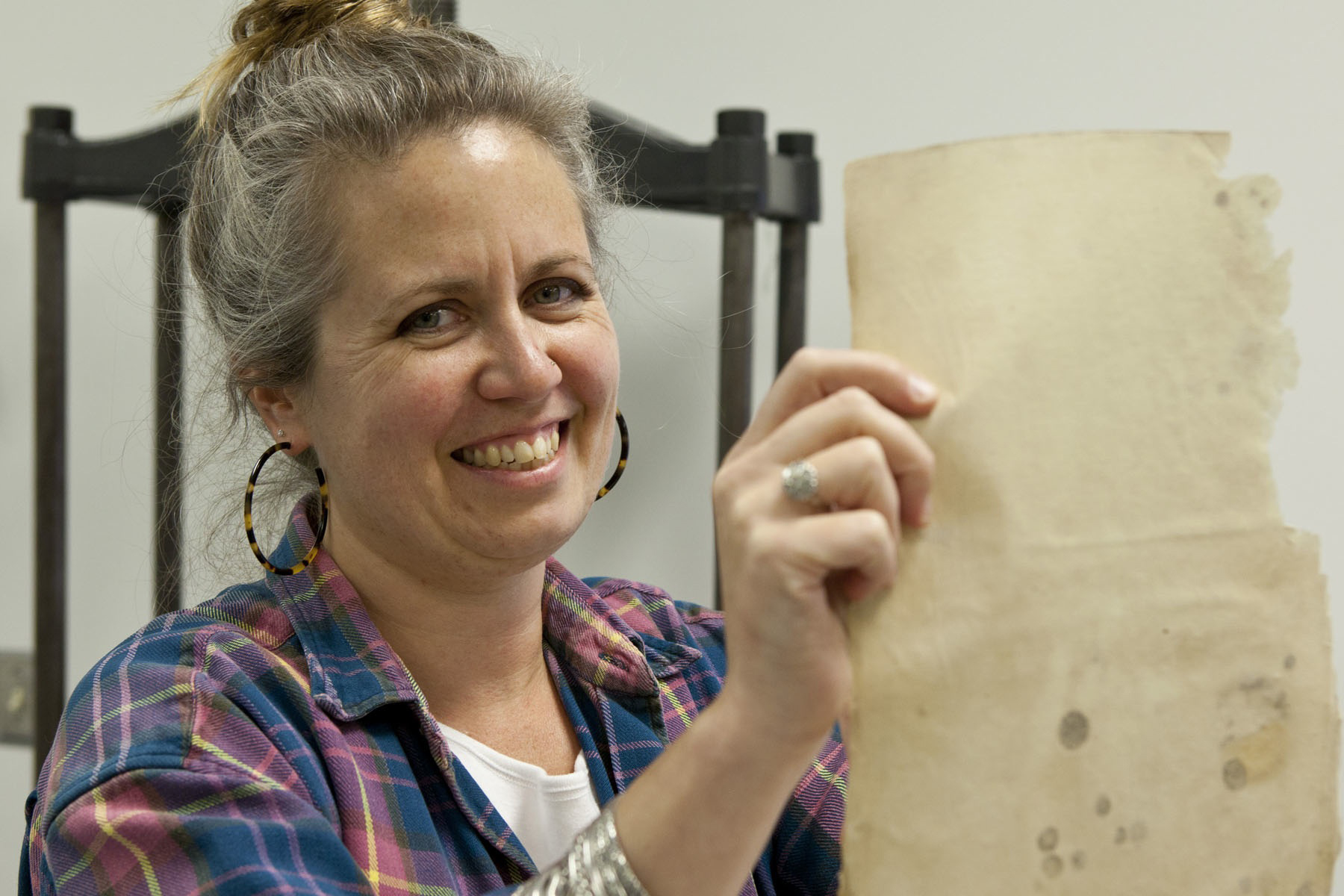In an equipment-filled lab that looks as if it might be shared by a 19th-century bookbinder and a present-day chemist, Eliza Gilligan, the University of Virginia's conservator for library collections, examined a letter U.S. Rep. John Randolph of Roanoke wrote on Dec. 5, 1807.
Despite its age, the neat cursive script of the letter – a dinner invitation – is clearly legible. The trouble is that before it became part of the John Randolph collection in the Albert and Shirley Small Special Collections Library, a well-meaning but ill-advised previous owner mended it with tape, which can damage documents as it oxidizes.
"For something like this, if it's in really bad shape, I might use the fume trunk and put some acetone on it to help remove the adhesive," Gilligan said, referring to some of the equipment that surrounded her.
Gilligan and her audio-visual counterpart, Steven Villereal, have over the past few years created specialized laboratories to restore and service rare books, tapes and other materials housed within the library system. As a result, the University has expanded its ability to preserve and repair its collections, which range from the papers of Thomas Jefferson to television news coverage of the Civil Rights Movement, and has created a resource for scholars interested in such materials.
Gilligan, who came to the University from the Smithsonian Institution Libraries, works primarily on books and other printed materials within Special Collections and has undertaken projects from investigating and restoring a mysterious copy of Robert Hooke's 1665 book "Micrographia" to assembling a period-accurate replica of the minutes of U.Va.'s very first Board of Visitors meeting as an inauguration gift for President Teresa A. Sullivan.
Villereal, whose lab spaces are in Clemons Library, digitizes and preserves rare audio and video recordings housed within the library's collections, often at the request of researchers and scholars on Grounds. In response to such a request, he recently digitized a reel-to-reel recording of a 1963 interview of the founder of the American Nazi Party.
Funded by a $1.5 million grant from the Andrew W. Mellon Foundation, the library has expanded its preservation efforts to care for both its circulating collections – books or other materials damaged by time or frequent use – and the rarer materials housed within Special Collections.
"Having facilities in-house really gives us an advantage," said Kara M. McClurken, the library's head of preservation services. "If we have enough items in need of preservation, it's a lot more cost-effective to do it here than to outsource it. It also shows our users and our potential donors that the University really values the collections we have."
For both Gilligan and Villereal, putting labs together meant assembling combinations of modern technology and rare, highly specialized equipment that is often hard to find.
In her lab in the Dell Building, Gilligan has a board shear – sort of like a table-sized version of paper-cutters used in school classrooms – that likely dates to the mid-19th century. Nearby is a standing press, a large metal device used to hold a book in place while glue dries. Both were supplied by Paul Brubaker at Bindery Tools, a vendor who Gilligan said is among a very few in the country who specialize in such materials. She also has a a 6-foot-by-4-foot washing sink and equipment for hand-tooling gold lettering on a leather book cover, as well as other devices both new and old.
Gilligan conserves books or other documents using their original materials, and sometimes must also create new parts, such as covers or bindings; her lab includes tools to work with leather and vellum.
She's currently working through the papers of Randolph to assess and repair them as necessary, and recently completed treatment of Andrea Palladio's 1581 treatise "I Quattro Libri dell'architettura," currently on exhibit at the U.Va. Art Museum.
Though the materials Villereal works on are only decades old instead of centuries, he must contend with the rapid changes in audio-visual technology. It's getting harder and harder to find a professional-quality reel-to-reel player, for instance, or to find someone capable of repairing the magnetic heads necessary for reading audio or video tape.
"At this point, the best practice for different types of tape is to digitize them instead of only trying to preserve them," said Villereal, who came to U.Va. in 2009 after completing graduate work in audio-visual conservation at New York University.
Though he currently works primarily on requests from faculty or staff, Villereal anticipates undertaking "collection-level" work, where he'd go through existing inventory in Special Collections or elsewhere to find tape that needs to be digitized.
"Especially in recent years, almost every collection of personal papers or other materials contains at least some audio-visual material," he said.
In addition to the lab space, the grant funds allowed the library to greatly expand the equipment and supplies necessary to maintain the circulating collections and to purchase materials to aid in disaster preparedness and recovery, McClurken said.
"It's not just the facilities; it's the expert staff," McClurken said. "If we didn't have Eliza and Steven, we'd be sending all this out to vendors. The staff here knows the collections best and they have a vested interest in making sure the conservation work is done in the most effective way possible, honoring both the integrity of the original object and enhancing usability for current and future researchers."
Media Contact
Article Information
November 30, 2011
/content/bookbinding-and-reel-reel-library-assembles-preservation-labs-rare-books-audio-visual

